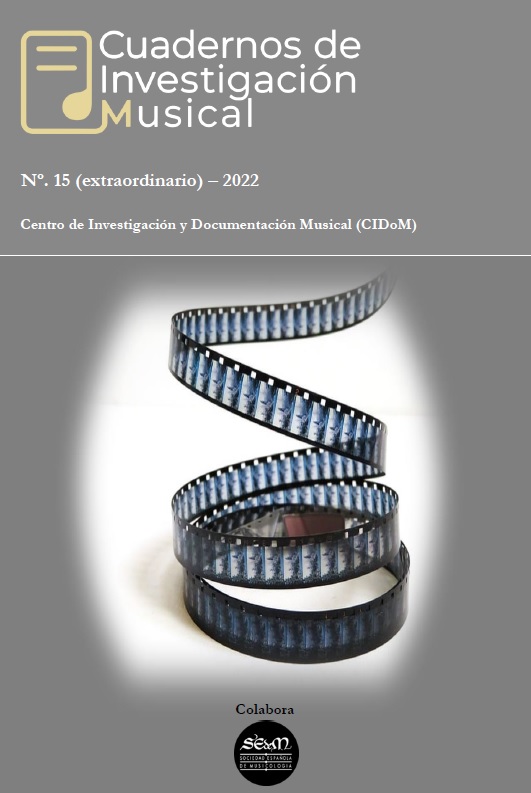Swashbucklers and Femme Fatales: Gender Coding in John Williams's Score to Indiana Jones and the Kingdom of the Crystal Skull (2008)
Main Article Content
Abstract
Despite having literally and figuratively ridden into the sunset in 1989, Hollywood’s favourite adventuring archaeologist returned in 2008’s Indiana Jones and the Kingdom of the Crystal Skull. John Williams’s score continued to revel in the established styles and codes befitting of the series’ nostalgic references: 40s and 50s B-movies. In addition to resurrecting beloved themes, the composer penned new themes for characters who, in part, progressed the franchise’s traditional gender roles. This article investigates how Williams’s neoclassical score lingers in the rigid gender codes of Hollywood’s past, at the expense of forming innovative thematic identities less reflective of traditional archetypes.
Article Details
Los autores de los artículos mantienen el copyright, no recibirán ninguna contraprestación económica por el trabajo y el mismo siempre será reconocido como exclusivamente suyo. La revista se compromete a proteger la integridad y originalidad del artículo, así como los derechos de autor que correspondan. Los autores son los únicos responsables del material, textos e imágenes que utilizan en sus respectivos trabajos, debiendo respetar siempre los derechos de autor de terceras personas, por lo que la revista no se hace responsable de lo contenido en este tema respecto al trabajo de los autores.
References
Audissino, E. (2021). The film music of John Williams: Reviving Hollywood’s classical style (2nd ed.). Madison, WI: University of Wisconsin Press.
Buhler, J. (2019). Theories of the soundtrack. New York, NY: Oxford University Press.
Edgar, G. (2021). “I am no lady when I fight!”: Gender politics in the postwar swashbuckler score. In J. Buhler & M. Durrand (Eds.), Music in action film: Sounds like action! (pp. 37-58). New York, NY: Routledge.
Friedman, L. (2006). Citizen Spielberg. Urbana and Chicago: University of Illinois Press.
Fülöp, R. (2012). Heroes, dames, and damsels in distress: Constructing gender types in classical Hollywood film music (Doctoral thesis, University of Michigan). Retrieved from https://deepblue.lib.umich.edu/handle/2027.42/95951
Graebner, J. (2008, September 6). John Williams: A Hollywood Legend (Concert Review) [Blog Post]. Retrieved from https://blog.bigbeaks.com/2008/09/06/john-williams-a-hollywood-legend-concert-review/
Halfyard, J.K. & Hancock, V. (2012). Scoring fantasy girls: Music and female agency in Indiana Jones and The Mummy films. In J.K. Halfyard (Ed.), Music of fantasy cinema (pp. 175-192). Bristol, United Kingdom: Equinox Publishing Ltd.
Jameson, F. (1991). Postmodernism, or, the cultural logic of late capitalism. Durham, NC: Duke University Press.
Kalynak, K. (1982). The fallen woman and the virtuous wife: Musical stereotypes in The Informer, Gone With the Wind, and Laura. Film Reader, 5, 76-82.
Kassabian, A. (2000). Hearing film: Tracking identifications in contemporary Hollywood film music. New York & London: Routledge.
Lehman, F. (2021). A guide to the musical themes of Indiana Jones: Music by John Williams. Retrieved from https://franklehman.com/indiana-jones-themes/
McQuiston, K. (2016). The soundtrack doth repeat too much: Or, the musical spectacle of keeping up appearances in Robert Altman’s “The Long Goodbye”. Literature/Film Quarterly, 2(16), 132-149.
Schneller, T. (2015). Modal interchange and semantic resonance in themes by John Williams. Journal of Film Music, 6(1), 49-74.
Smith, S.C. (2020). Music by Max Steiner: The epic life of Hollywood’s most influential composer. New York, NY: Oxford University Press.
Videography
Bouzereau, L. (Director). (2008). “Indiana Jones and the kingdom of the crystal skull” documentaries [DVD]. United States: Paramount Pictures.
lavaman2000. (2009, March 17). JOHN WILLIAMS INDIANA JONES 4 LIVE HB 2008 [Video file]. Retrieved from https://www.youtube.com/watch?v=7c70cJxPE04
Spielberg, S. (Director). (2008). Indiana Jones and the kingdom of the crystal skull [DVD]. United States: Paramount Pictures.
